Denial Of Liability Letter
Subject: Denial of Liability
Dear [Recipient's Name],
I am writing this letter in response to the recent claim made against me [or your company/organization] regarding liability for [describe the incident or event]. After careful consideration and review of the circumstances surrounding the incident, I regret to inform you that I cannot accept any liability for the alleged damages or losses.
I would like to provide you with a detailed explanation of my reasons for denying liability:
1. Lack of Negligence: After a thorough investigation of the incident, it has become clear that there was no negligence on my part [or the part of my company/organization]. I took all reasonable precautions to prevent any harm or damage, and the incident occurred due to unforeseen circumstances beyond my control.
2. Contributory Negligence: Upon examination of the facts, it has become evident that the claimant or a third party contributed to the incident through their own actions or failure to take necessary precautions. Their actions were the primary cause of the damages or losses claimed, relieving me [or my company/organization] of any liability.
3. Inadequate Evidence: The evidence presented in support of the claim is insufficient and does not establish a clear link between the incident and any actions or omissions on my part [or the part of my company/organization]. Without substantial evidence, it is not possible to attribute liability accurately.
I understand the concerns and frustrations that may arise from this denial of liability. However, I assure you that I have carefully assessed the situation, and my decision is based on objective evaluation and legal advice.
Should you wish to discuss this matter further or provide additional evidence supporting your claim, I am open to reconsidering my position. Please contact me within [a reasonable time frame, e.g., 14 days] if you would like to proceed with further discussions or submit any new evidence.
Please note that this letter does not waive any of my rights or defenses and should not be construed as an admission of liability. It is important to consult with legal counsel to understand your rights and options for pursuing this matter further.
Thank you for your understanding in this matter. I trust that you will respect my decision based on the information provided. I hope that we can resolve this issue amicably and avoid any further escalation.
Yours sincerely,
[Your Name]
Formal Denial Of Liability Letter
Dear [Recipient Name],
We are writing in response to your claim regarding [brief description of incident]. After a thorough review of the facts and circumstances, we must formally deny any liability in this matter.
Our investigation indicates that [reason for denial]. As such, we are unable to assume responsibility for the claims presented.
We appreciate your understanding in this matter.
Sincerely,
[Your Name]
[Your Position]
[Company/Organization Name]
Professional Denial Of Liability Email
Dear [Recipient Name],
Thank you for contacting us regarding [incident or claim]. After careful evaluation, we must clarify that our organization does not accept liability for this situation.
We have reviewed all relevant documentation and circumstances and found that [reasoning for denial]. Please consider this as our official position on the matter.
If you require further clarification, do not hesitate to contact us.
Best regards,
[Your Name]
[Your Position]
[Company Name]
Provisional Denial Of Liability Letter
Dear [Recipient Name],
This letter serves as a provisional denial of liability concerning your claim dated [date]. Based on our preliminary assessment, we are unable to assume responsibility at this stage.
Further investigation may be required, and we will notify you if any changes to our position occur. Currently, our findings indicate [brief reasoning].
Thank you for your understanding.
Sincerely,
[Your Name]
[Your Position]
[Organization Name]
Informal Denial Of Liability Message
Hi [Recipient Name],
We’ve reviewed your claim about [incident]. At this point, we must let you know that we are unable to accept liability for the situation described.
This is based on [brief reason]. If you have additional information that could affect our decision, feel free to share it.
Thanks for your cooperation.
Best,
[Your Name]
[Company Name]
Legal Denial Of Liability Letter
Dear [Recipient Name],
This letter is to formally notify you that [Company/Organization Name] denies any liability related to [incident or claim]. Our position is based on the facts, contracts, and applicable laws governing this matter.
We advise you to review our response carefully. No admission of responsibility is implied or intended.
Sincerely,
[Your Name]
[Title]
[Company/Organization Name]
[Contact Information]
Quick Denial Of Liability Email
Dear [Recipient Name],
Following our review of your claim regarding [incident], we must inform you that we do not accept liability in this matter.
Thank you for your understanding.
Regards,
[Your Name]
[Company Name]
What is a Denial Of Liability Letter and Why it is Used
A Denial Of Liability Letter is a formal communication issued to reject responsibility for a claim, incident, or damage.
Purposes include:
- Protecting an organization or individual from legal or financial claims.
- Documenting the official position in a dispute.
- Preventing misunderstandings or false expectations.
- Providing a written record for legal or administrative purposes.
Who Should Send a Denial Of Liability Letter
- Company representatives or legal departments addressing claims.
- Property owners or service providers responding to accidents or damages.
- Insurance companies clarifying coverage and liability.
- Individuals or entities involved in disputes seeking to formally deny responsibility.
Whom Should Receive the Denial Of Liability Letter
- Claimants or individuals making a request for compensation.
- Legal representatives of the claimant.
- Insurance agents or brokers involved in the incident.
- Regulatory authorities or third-party intermediaries if required.
When to Send a Denial Of Liability Letter
- Immediately after receiving a claim that is not valid.
- Following internal investigation confirming no responsibility.
- During disputes involving contracts, services, or property damage.
- Before or during potential legal proceedings to formally record your position.
How to Write and Send a Denial Of Liability Letter
Steps to craft a clear letter:
- Begin with a formal greeting addressing the claimant or recipient.
- State clearly that liability is denied.
- Provide reasoning or reference supporting documents, contracts, or laws.
- Avoid emotional or confrontational language.
- Offer a point of contact for further clarification.
- Send via certified mail or email with read receipt for documentation purposes.
Formatting Guidelines for Denial Of Liability Letters
- Length: 1–2 pages, concise but detailed.
- Tone: Formal, professional, and neutral; legal tone when required.
- Wording: Clear, direct, and unambiguous.
- Style: Formal letter or official email depending on recipient.
- Mode: Email for quick communication; printed and signed letters for legal purposes.
- Etiquette: Avoid admitting responsibility; maintain professionalism at all times.
Requirements and Prerequisites Before Sending
- Review all relevant facts, documents, and evidence.
- Consult legal or compliance teams if necessary.
- Identify the correct recipient and confirm contact details.
- Determine the exact reasoning for denying liability.
- Prepare supporting documentation to reference in the letter if needed.
Common Mistakes to Avoid
- Using vague or ambiguous language.
- Admitting responsibility unintentionally.
- Sending the letter without verifying facts or legal standing.
- Omitting important details or reference documents.
- Using unprofessional tone or emotional language.
Elements and Structure of a Denial Of Liability Letter
- Salutation addressing the recipient.
- Clear statement of denial of liability.
- Explanation or justification for the denial.
- Reference to supporting evidence, laws, or agreements.
- Closing remarks with contact information for inquiries.
- Signature of the authorized person.
Tricks and Tips for Effective Denial Of Liability Letters
- Keep language professional and neutral to avoid escalation.
- Include relevant facts, dates, and documentation references.
- Avoid speculation; stick to verified information.
- Consider sending via tracked mail for proof of delivery.
- Consult legal counsel for complex or high-risk cases.
After Sending the Denial Of Liability Letter
- Keep a copy for records and potential legal reference.
- Monitor for responses or counterclaims.
- Be prepared to provide additional documentation if requested.
- Consult legal counsel if the recipient escalates the claim or initiates proceedings.
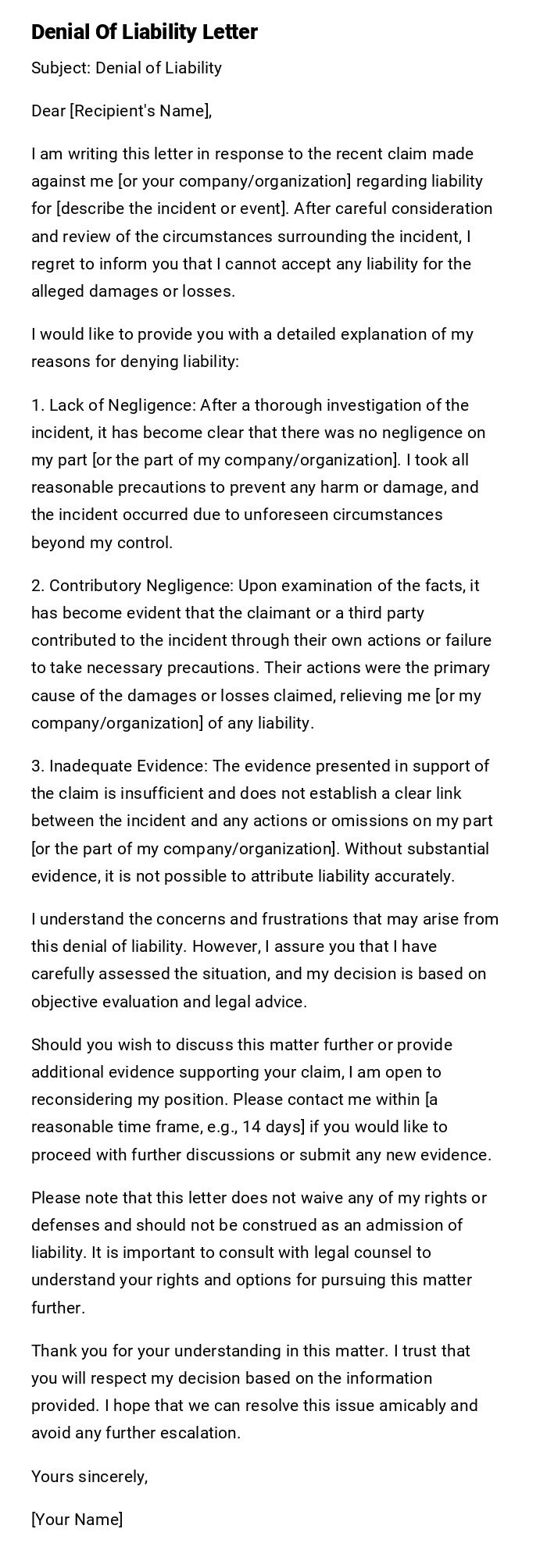
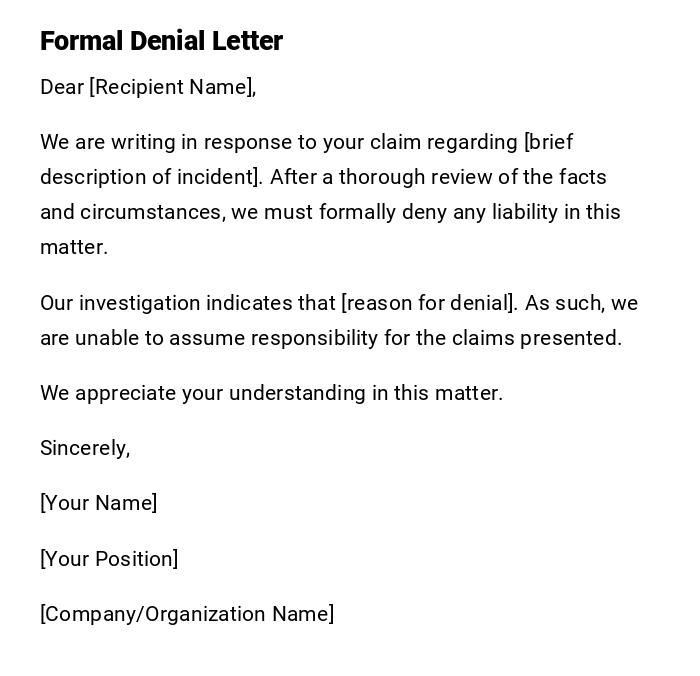
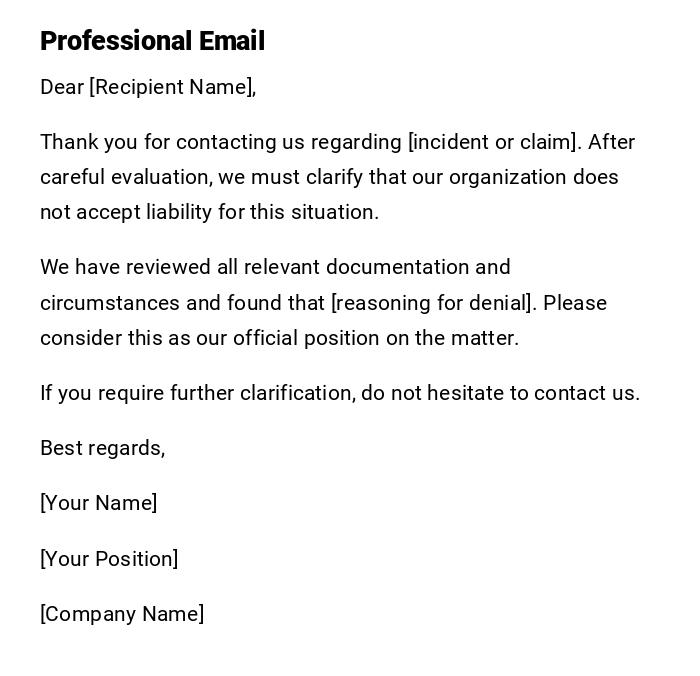
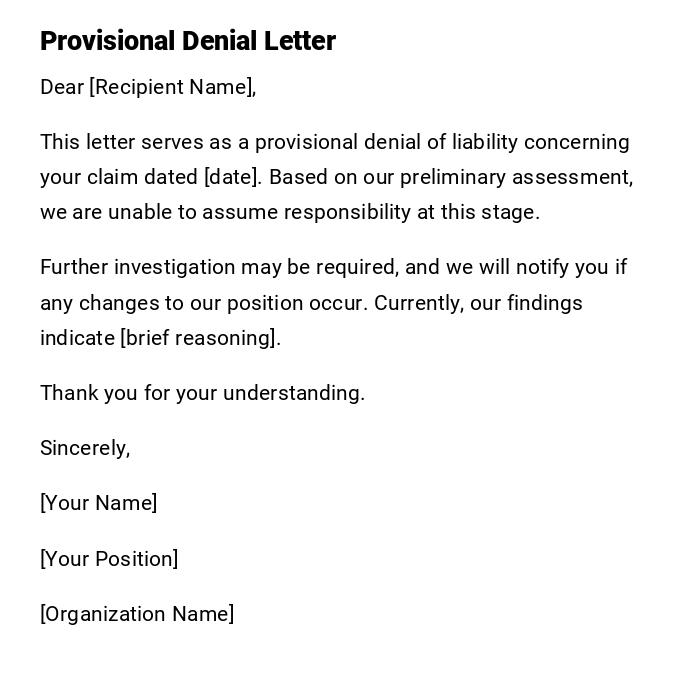
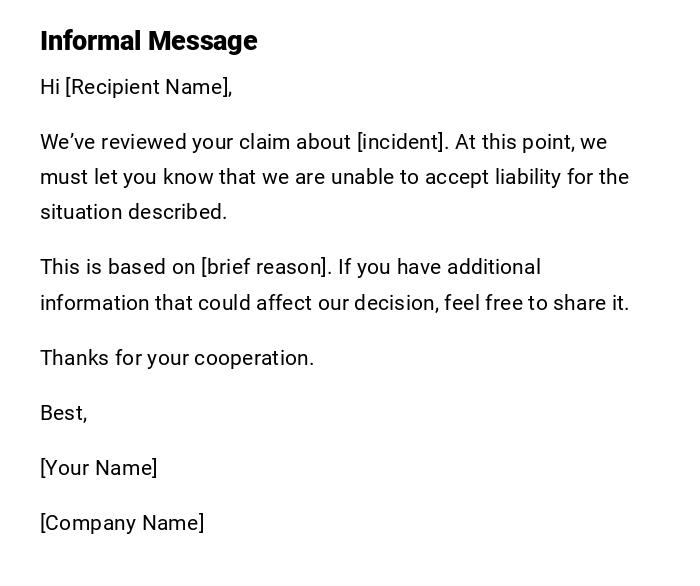
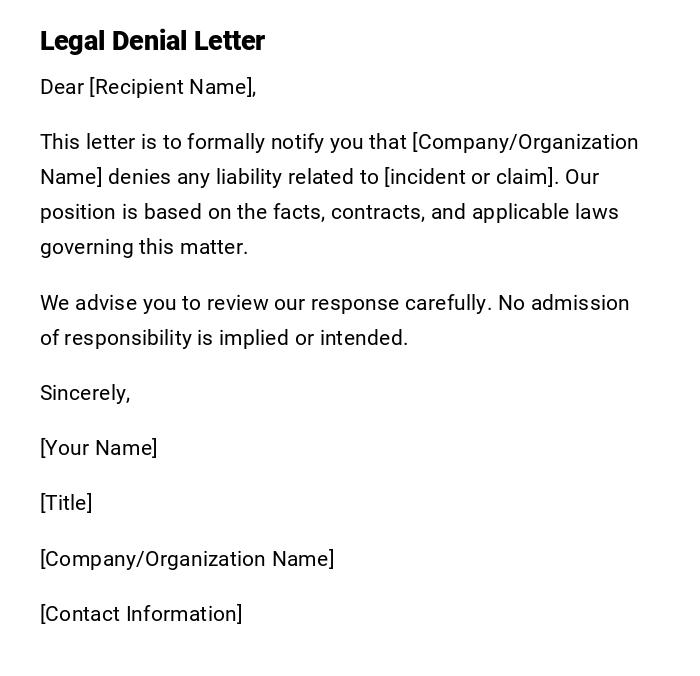
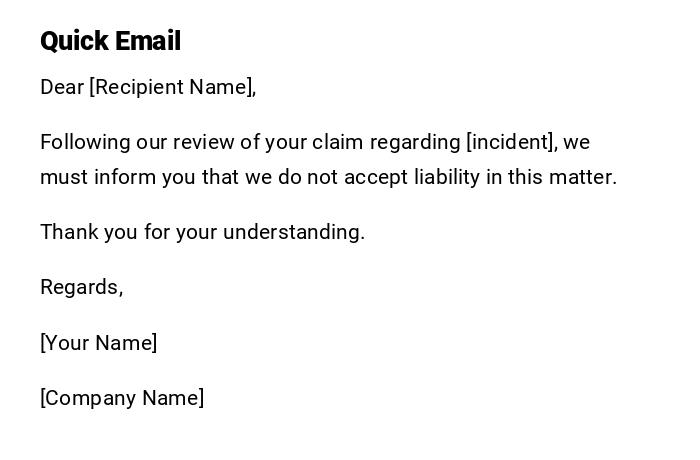

 Download Word Doc
Download Word Doc
 Download PDF
Download PDF